Karanji is a sweet snack from the Maharashtrian cuisine and often made for festivals, but are so delicious you’ll want to eat them all year long. These half moon-shaped fried pastries are stuffed with a mix of shredded coconut, dried fruits, sesame seeds and delightful seasonings. Here I share a beloved family karanji recipe with step-by-step instructions and photos.

What is Karanji
For as long as I can remember we’ve had karanji as part of our festive occasions. Sweet snacks are a big part of celebrations like Diwali and Ganesh Chaturthi, so these crispy stuffed treats are always a must-have.
In North India, the karanji variant is called Gujiya. There are many different versions of karanji recipes that can be made. Usually they include a simple pastry dough that’s cut into circles, loaded with a variety of sweet goodies and spices, shaped into half moons and deep fried.
They’re similar to fried dumplings or empanadas, with a deliciously flaky crust more like fruit hand pies. All over India they are known by different names and are made with some variations – called as Karjikai or Karigadubu (in Kannada), Kajjikayalu (in Telugu), Ghughra (in Gujarati) and Somas (in Tamil).
These traditional karanji are stuffed with a blend of roasted desiccated (shredded) coconut, sesame seeds, nuts, raisins, and vibrant spices. It’s my mom’s classic karanji recipe, and I think you’ll agree it is the best.
One bite of karanji with a perfectly flaky, crispy and buttery crust filled with a melt-in-your-mouth sweet coconut stuffing will have you hooked!
If you are looking to make recipes for Diwali festival then you can check these two collections of Diwali Sweets and Diwali Snacks.
How to Make Karanji Recipe
Prepare the Stuffing
1. Heat ½ tablespoon ghee in a small frying pan. Add the desiccated coconut. Make sure the coconut is of finer texture and does not have long shreds.
Tip: If you have desiccated coconut with long shreds, then using a spice-grinder or a mixer-grinder, grind or powder them to a finer texture.

2. Roast, stirring often, till the coconut turns golden. Remove the coconut in a plate and set aside.
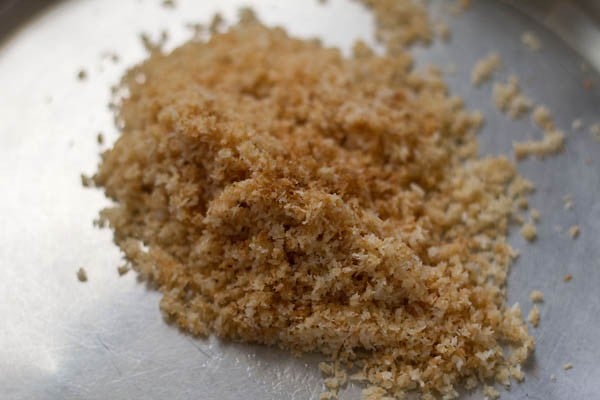
3. In the same pan on low heat, add the white sesame seeds and roast till they pop and change color. Set aside together with the roasted coconut.

4. In a dry grinder or coffee grinder, grind or powder 8 to 9 almonds, 9 to 10 cashews, and 9 to 10 golden raisins to a semi fine mixture. You can also choose to finely chop the dry fruits with a knife.

5. Add this ground dry fruits mixture to the sesame seeds and coconut mixture.

6. Now add 3 tablespoons powdered sugar (or confectioner’s sugar), a pinch of grated nutmeg or nutmeg powder and ½ teaspoon cardamom powder. Mix everything well and set the stuffing aside.

Make the Dough
7. Heat 2 tablespoons ghee first in a small pan over low heat.
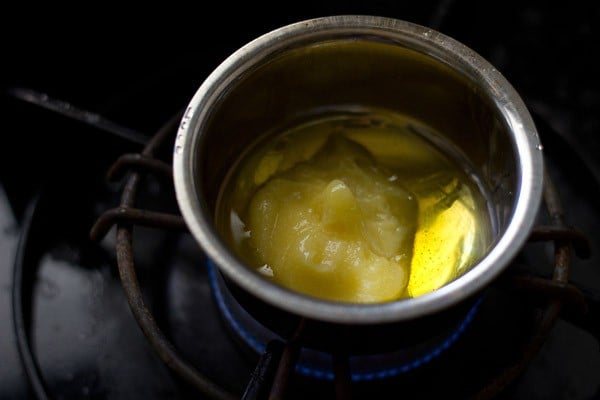
8. In a bowl or pan, add 2 cups all-purpose flour (maida). Make a well in the center of the flour and add the hot melted ghee and ¼ teaspoon salt in it.
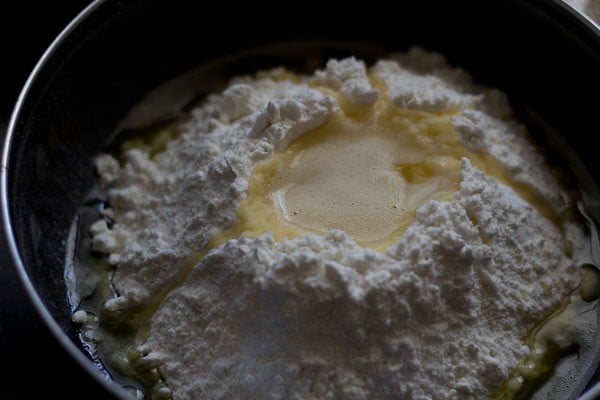
9. Lightly mix everything together with a spoon. Do not over mix!
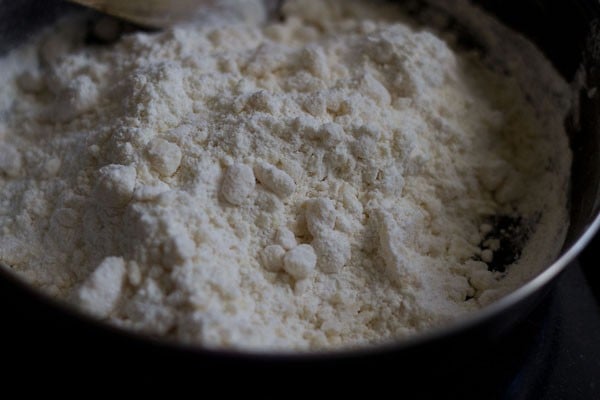
10. Add milk (about ½ cup + 1 tablespoon) just a bit at a time and begin to knead the dough.
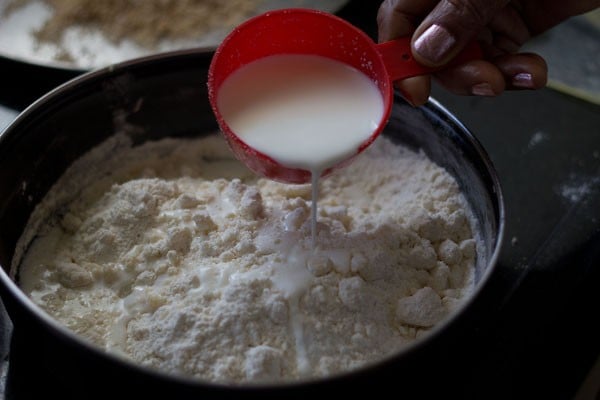
11. Continue to knead the dough adding milk in parts.
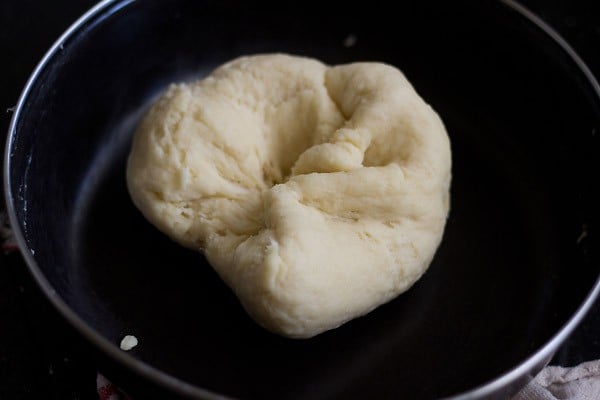
12. Knead the dough till it forms into a nice smooth ball. Keep in mind that the dough has to be smooth but also tight and firm.
Do not knead to a dough like that of roti dough. Also do not knead the dough for too long. A soft dough will make for a soft crust after frying.

13. Cover the dough with a moist kitchen towel and keep aside for 15 to 20 minutes.

Assemble, Fill and Shape Karanji
14. When it’s done resting, divide the dough into two parts. Roll each part into a log and begin to cut the log in equal slices. You should have about 6 sections.
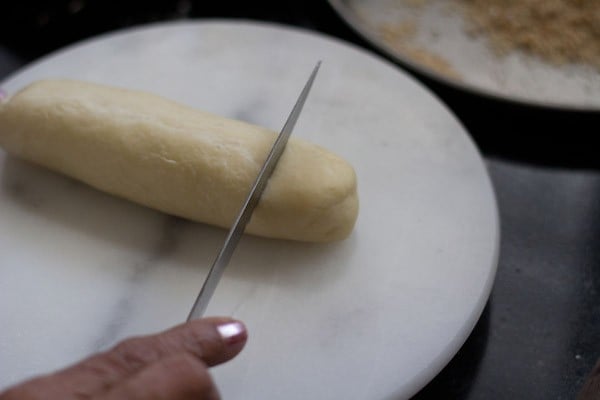
15. Take each slice and roll it between your palms and flatten it.
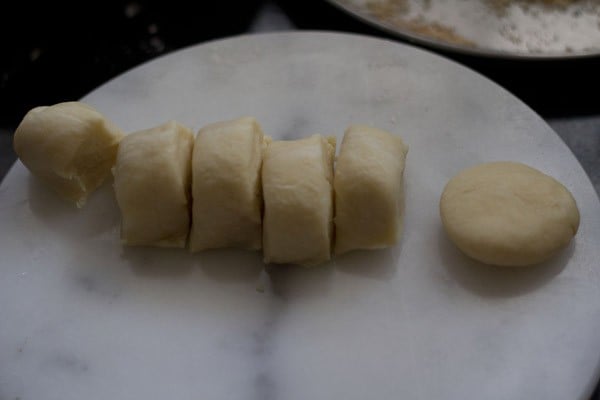
16. Place the dough on a lightly floured surface and use a rolling pin to roll the dough out in a 4 to 5 inches diameter circle.
Cover the other slices with a moist kitchen towel while you’re rolling so they don’t get dried out.
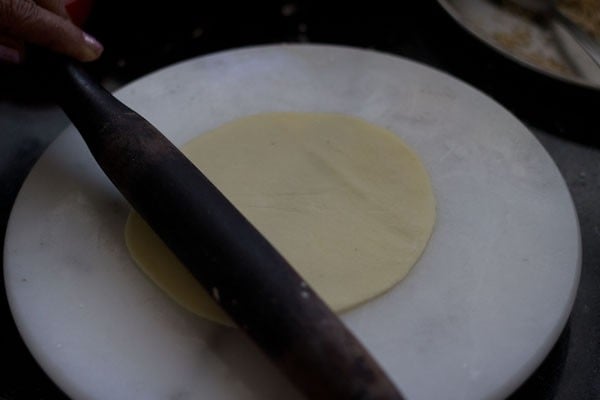
17. Next, add 1 to 2 tablespoons of the coconut stuffing in the center of the circle, keeping the edges empty.
Don’t add too much of stuffing or it’s difficult to shape them and the karanji may break in the oil.
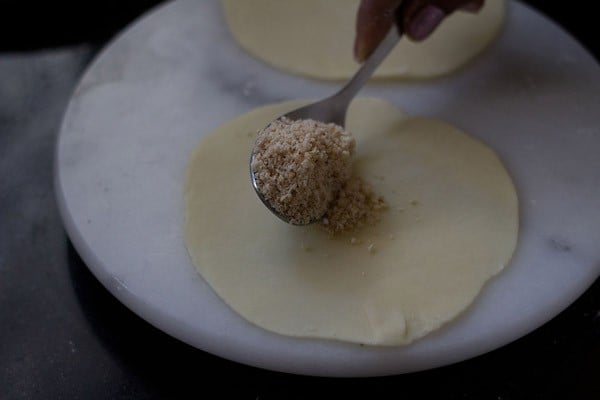
18. With your fingertips or a pastry brush, apply water all over the circumference edge.
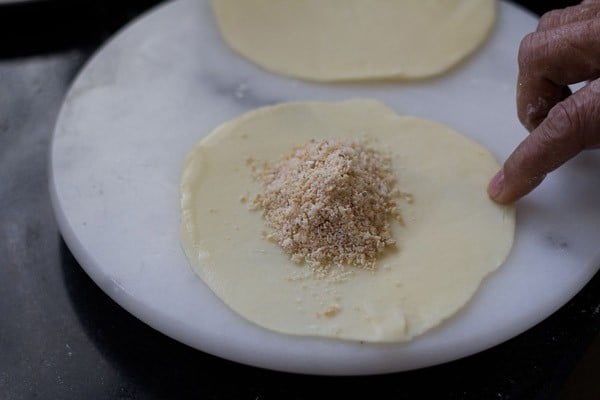
19. Carefully, bring together both the edges and join.

20. Gently press the edges so that it is sealed across.
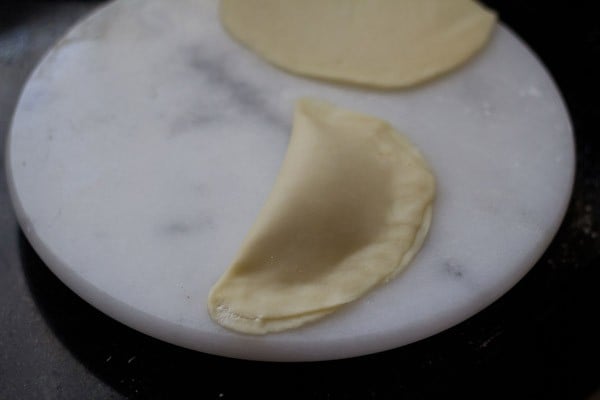
21. Now with your fingertips, start pinching and pleating the pressed edges. This is similar to shaping a dumpling or empanada. You can also press the edges with a fork instead of pleating them.

22. Continue pleating till you come to the end, and seal with a final pleat.
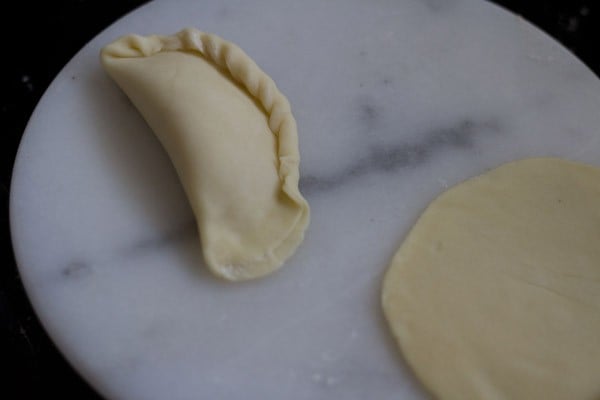
Deep Fry Karanji
23. Gently place the karanji in a moderately hot oil for deep frying. Only fry 2 to 3 karanji at a time, depending on the size of your kadai or pan.
Too many will drop the oil temperature and make them difficult to properly fry. So you have to fry the karanji in batches.
Tip 1: The oil has to medium hot. If it is very hot, the karanji will become browned faster and the pastry dough will be undercooked.
Tip 2: If the oil is warm or not hot enough, the karanji will absorb a lot of oil and get loaded with it.
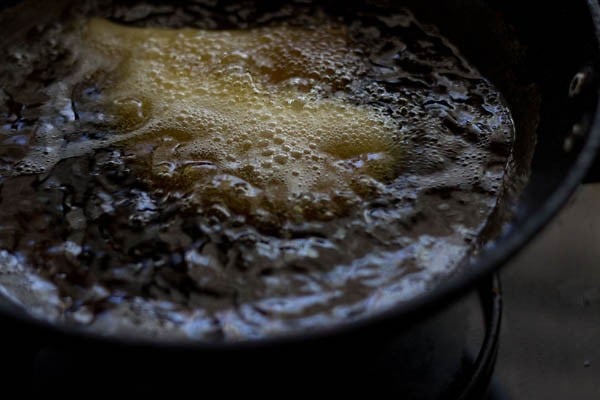
24. When one side is golden, using a slotted spoon gently turn over each karanji. Fry the second side until golden.
Fry till crispy golden and puffy turning over as needed. Immediately remove and drain karanji on paper towels to remove excess oil.
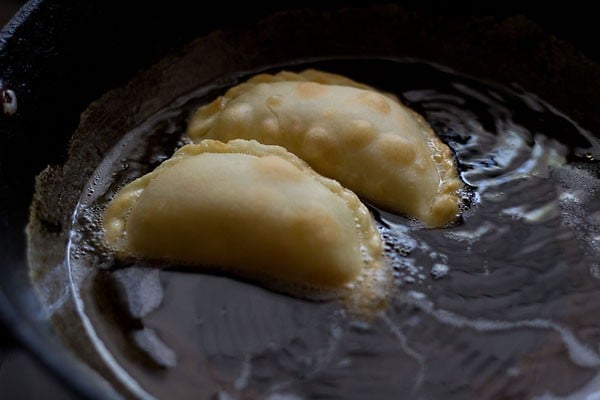
25. Once cooled, serve or store karanji in an air-tight container.
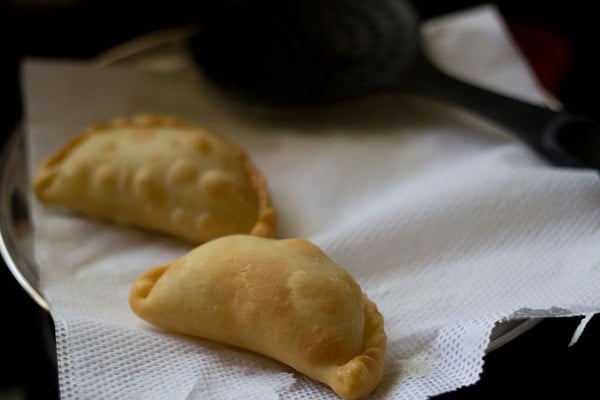
25. You can serve karanji warm or at room temperature. You can have them for next few weeks with tea or as a snack.
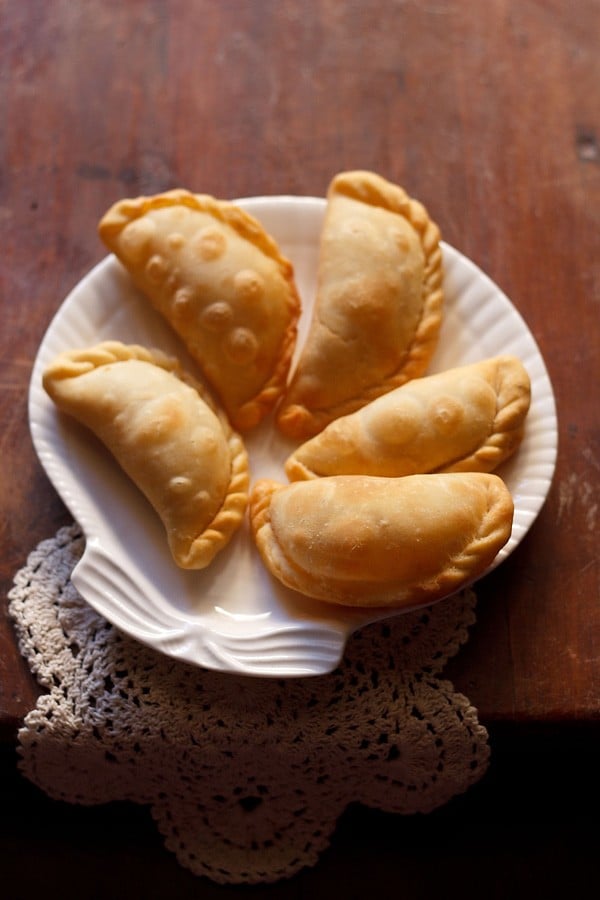
FAQs
Store cooled karanji in an airtight container and keep them at room temperature for up to a week.
This typically happens because either the dough has too much moisture, or the oil wasn’t hot enough to properly fry the karanji. When you make the dough you can add a bit more flour if it seems to loose or tacky. Also keep in mind to not make the dough soft. It has to be smooth but also tight and firm.
Test the oil with a bit of dough to see if it’s hot enough. if the dough sinks to the bottom without bubbling, the oil isn’t hot enough. You want the dough to rise steadily in the bubbly oil and then float at the top while it fries.
Certainly! Depending on diet and tastes feel free to leave out any of the nuts or swap raisins with other preferred dry fruit.
More Indian Festive Sweets!
Evening Snacks
Sweets Recipes
Ladoo Recipes
Sweets Recipes
Please be sure to rate the recipe in the recipe card or leave a comment below if you have made it. For more vegetarian inspirations, Sign Up for my emails or follow me on Instagram, Youtube, Facebook, Pinterest or Twitter.
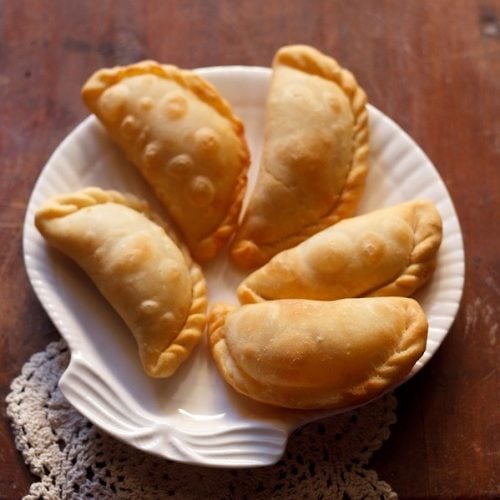
Karanji Recipe (Authentic)
Ingredients
For karanji stuffing
- ½ cup desiccated coconut – unsweetened
- 1 tablespoon white sesame seeds
- 8 to 9 almonds
- 9 to 10 cashews
- 9 to 10 golden raisins
- ½ teaspoon cardamom powder or 4 green cardamoms, crushed in mortar-pestle
- 3 tablespoons powdered sugar or confectioner's sugar, add as required
- 1 pinch nutmeg powder or grated nutmeg
- ½ tablespoon Ghee
For outer cover of karanji
- 2 cups all purpose flour (maida) – 250 grams
- 2 tablespoon Ghee
- ¼ teaspoon salt
- ½ cup milk + 1 tablespoon, or as required
More Ingredient
- oil as required, for deep frying
Instructions
Making sweet stuffing
- Heat ghee in a small frying pan.
- Add the desiccated coconut and roast stirring often till the coconut turns golden.
- Remove the coconut in a plate and keep aside.
- In the same pan, add the sesame seeds and roast till they pop and change color. Keep aside with the roasted coconut.
- In a dry grinder or coffee grinder, grind the almonds, cashews, raisins to a semi fine powder or mixture.
- You can also chop these dry fruits. If you prefer, you can also roast the dry fruits and then chop or powder them.
- Add this dry fruits mixture to the sesame seeds and coconut mixture.
- Add powdered sugar, nutmeg powder and cardamom powder.
- Mix everything well and keep the stuffing aside.
Making dough for karanji
- Heat the ghee first. Just lightly heat it.
- In a bowl or pan, take the flour. Add the hot melted ghee and salt. Just lightly mix everything with a spoon.
- Add milk in parts and knead the dough till smooth. The dough has to be smooth but also tight and firm. Do not make it soft like a roti dough.
- Cover the dough with a moist kitchen towel and keep aside for 15 to 20 mins.
Rolling, stuffing and shaping karanji
- Divide the dough into two parts. Roll each part into a log. Cut the log in equal slices.
- Take each slice of the dough and roll it between your palms to a round ball.
- With a rolling pin on a dusted board, roll the dough ball in 4 to 5 inches diameter circle.
- Place 1 to 2 tablespoons of the prepared stuffing in the center or on one side of the circle, keeping the edges empty.
- Make sure you don't over stuff as then it becomes difficult to shape the karanji. They may also break while frying.
- With your fingertips or with a pastry brush, apply water all over the outer edge.
- Gently bring together both the edges and join. Gently press the edges.
- Now with your fingertips, start pinching the pressed edges.
- Shape and make all karanji this way. Place them covered with a moist kitchen cotton towel before you fry them. This also helps in the dough not drying out.
Deep frying karanji
- Heat oil for deep frying in a pan or kadai until moderately hot. Gently place the prepared karanji in hot oil.
- Add a few karanji while deep frying and don't crowd them.
- When one side becomes golden, turn over gently and fry the second side. Turn over again when the second side is golden.
- Fry turning over as needed until crisp and golden. Remove with a slotted spoon and drain on paper towels to remove excess oil.
- Once cooled, store them in air-tight container. Serve karanji warm or at room temperature.
Notes
- Knead the dough to a tight and firm dough. A soft dough will make for a soft crust and it won’t be flaky and crispy.
- You can add less or more of the nuts in the stuffing.
- Fry in medium-hot oil in batches. Do not overcrowd the pan or kadai while frying.
- Scale this recipe to make a smaller or a larger batch.
- Note that the approximate nutrition info is for 1 karanji.
Nutrition Info (Approximate Values)
This Karanji Recipe post from the archives first published in June 2014 has been updated and republished on 21 October 2022.



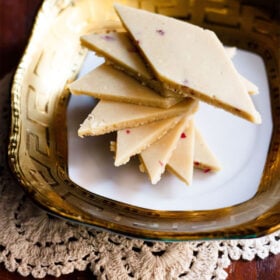
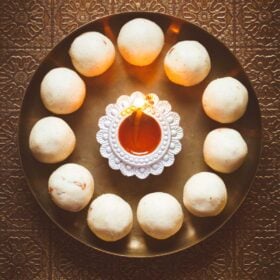
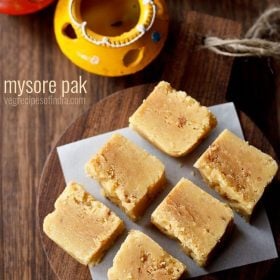
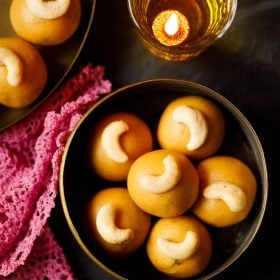
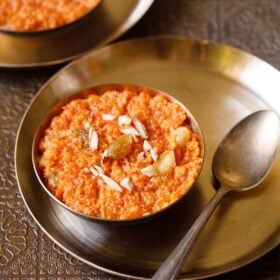
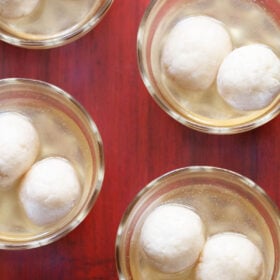









I tried before several time my karanjis outer part always become soft. can guess y. Playing me tips to turn crispy. Thank you
add less water while kneading dough and when frying the oil has to be hot. if fried at a low temperature of oil, the crust won’t become crisp.
आपकीआपकी सभी रेसिप बहोत ही सिम्पल और easy to make होती है
आपक पनीर बटर मसाला और बहुत सारी रेसिप मैने try किये है , सभी बहोत ही टेस्टी बने,
सभी रेसिप मे जो इन्ग्रेडीएन्ट्स है वो घर मे available होते है ,आपकी रर्सिप बिलकुल भी कॉम्प्लिकेटेड नाही होती
लेकींन मुझे महाराष्ट्रीयन style ओल्या नारळाची करंजी ये रेसिप नही मिली
प्लीज आप मुझे बता सकक्ती है??
dhanyawad and shukriya vandana ji. achcha laga aapka comment pad ke. fresh coconut ki karanji ke recipe bhi hain. uska link yeh hai – https://www.vegrecipesofindia.com/goan-nevris-recipe-neurios-recipe/
Hi!
I made the karanji today. I’m allergic to nuts. So I skipped the nuts. Also I baked these instead of deep frying. It was super yummy!! ???????? Thank you so much for the wonderful recipe. Next I’ll be trying your eggless coconut cookies this weekend. Thanks again!
thanks ramya. its nice to know that the baked karanjis turned out good. nuts or dry fruits can be skipped if it does not suit. i hope you enjoy baking the coconut cookies as well as like them.
The karanjis were very crispy when fresh but they became soft once they cooled down. What may have gone wrong??Otherwise awesome recipe.Your recipes are always a hit
deepti, once karanjis cool down at room temperature, keep them in an air-tight box. if they are not kept in a jar or box, they will become soft. thanks for the feedback on the recipes.